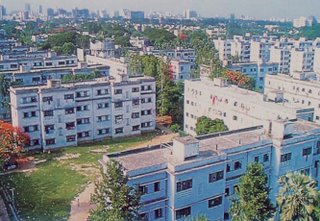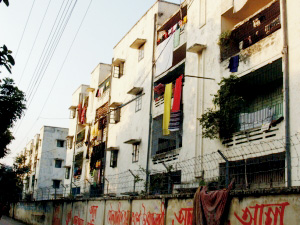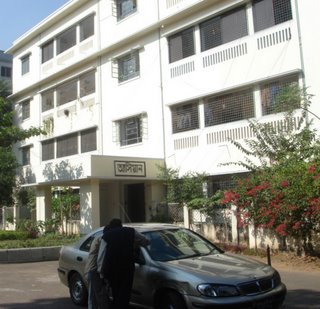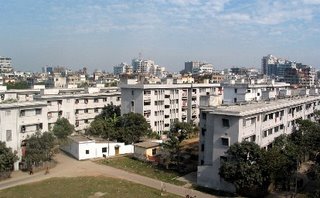
Azimpur Colony, Dhaka

Motijheel AGB Colony

Motijheel Colony

Colony for high officials at Ramna

Aminabad Colony - private

Green road Government Colony

Baily Road Officers' Colony

Baily Road Officers' Colony

Officers' quarters at Eskaton Garden Road
In 1840 James Tailor wrote: "Dhaka with the beautiful houses on the riverbank reminded one of Venice." But it was during the decade of the 1840s that those buildings began to wear away. When people used to come to see those buildings they only saw some structures on the verge of ruination.
The most picturesque area of Dhaka was located on the banks of the Buriganga, which was under the possession of the elite class. The mid 19th century saw the emergence of the Hindu professional/middle class in East Bengal. They began to buy some of the old houses or construct new ones. While the middle class was spreading in the town, the poor were also getting poorer.
Between the 1880s and 1890s, residential areas like Wari, Gandaria, Tikatuli, Swamibagh for the middle class elite were created. Those areas used to be parts of the main town. Much later, in the 1930s and 1940s, Purana Paltan and Segunbagicha also rose as residential areas. The architectural pattern of these houses was different from that of the old areas. The residential houses, mostly one to two-storied, looked beautiful with some open space in front. The town expanded towards the north where government was building the Secretariat and and Governor's house (High Court bldg) after Dhaka became the capital town of newly created province of East Bengal and Assam. In the forest area of Ramna, rich people were buying land. After the partition of Bengal was nullified in 1912, the pace of development slowed down and Dhaka reverted back to the status of a district town. In the wake of World War II, a cantonment and airstrip was constructed in the north of town for action in Burma front.
After partition of India in 1947, Dhaka became the provincial capital of Eastern part of Pakistan. New offices were set up and business communities grew in Dhaka. Due to sudden onrush of people residential need of the town increased manifold. Arrival of large numbers of Muslim population from India in 1947-50 led to a 100% increase of population, which in turn led to new settlements in the vacant areas within the city, as well as in the outskirts of Mohammadpur and Mirpur. Dhaka's urban area increased from 6 square miles in 1947 to 25 square miles within a decade. Semi permanent sheds for government staff started in the Nilkhet and Palashi Barrack (established by the English in the post-Sepoy war period). In 1949-51, 3-storied residential colonies were built in Azimpur and Motijheel. For top officials, colony was built in Ramna and Eskaton. Construction of the New Market was completed in 1954.
The areas from Purana Paltan to Naya Paltan, Eskaton to Maghbazar, Siddheswari and Kakrail to Kamlapur, Rajarbagh and Shantinagar were covered by scattered construction. Motijheel, once desolate and on the fringe of marshes and swamps, was earmarked as a commercial area in 1954. The area north of the Nawabpur Railway crossing up to Purana Paltan was developed as an open area with the stadium (present Bangabandhu National Stadium), forming the nerve centre of sporting activities. In the 1950s, for the first time, a dual carriageway was built from the north of Nawabpur road (Jinnah Avenue later renamed BB Avenua) extended up to Tejgaon Airport.
The sudden influx of population in the post-1947 period created the 'new Dhaka' in the available highland north, north-east and north-west of Ramna. The 'old Dhaka' of the Mughals, nourished by the Nawab family in the late 19th and early 20th century again reverberated with life.

No comments:
Post a Comment